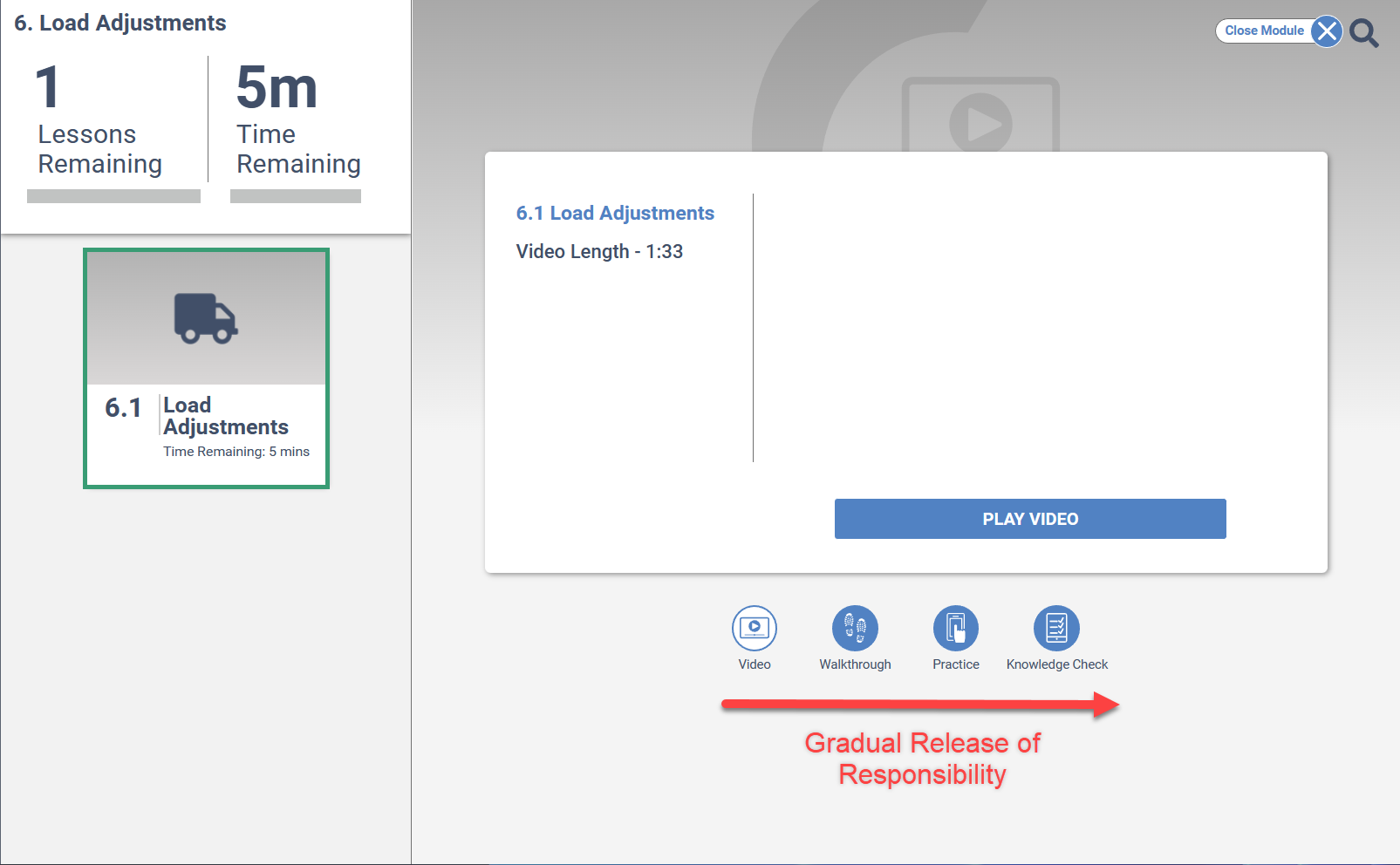- DarkLight
Skyllful Instructional Design Foundations
Article Overview
Skyllful helps business leaders and their most critical frontline workers use technology to make their work easier, more efficient, and safer. This is achieved through the Skyllful training applications that were founded on data-based learning principles, theories, and best practices. The following summarizes a few key pillars that guide the continued development of Skyllful's platform.
- Gradual Release of Responsibility
- Adult Learning Theory
- Active Learning
- Information Processing Theory & Microlearning
- Learning-by-Doing Principle
1) Gradual Release of Responsibility
The Gradual Release Model of instructional design creates a scaffolded system of learning tools, supports, and tasks. Learners graduate from full support to independent performance through 4 unique but repetitive phases that target the learning objective.
| I DO | WE DO TOGETHER | YOU DO WITH SUPPORT | YOU DO INDEPENDENTLY |
|---|---|---|---|
| The learner receives full support wherein the task required of the learning objective is demonstrated. | The learner is given full support while they actively engage with the learning objective. | The learner is given support only when a mistake is made and feedback is required. | The learner is not given support; rather, a safe environment where they are free to learn through trial & error. Ultimately, this is where they show unsupported mastery of the learning objective. |
| Skyllful's Video Mode | Skyllful's Walkthrough Mode | Skyllful's Practice Mode | Skyllful's Knowledge Check Mode |
This is a screen capture of Skyllful Simulator's learning environment. You can see the Gradual Release Model is an embedded design feature of the learning experience.
2) Adult Learning Theory
Malcolm Knowles is renowned in the learning industry for his research regarding adult learner characteristics. He is best known for his concise assumptions and principles that guide instructional design for adult audiences.
| Knowles' Assumptions & Principles | Skyllful's Application of Adult Learning Theory |
|---|---|
| Adults are self-directed learners & prefer some level of control over their training. | Skyllful exploits asynchronous learning opportunities and creates self-directed pathways towards mastery. |
| Adults rely heavily on internal motivation vs. external motivators. | Skyllful's microlearning environment creates an abundance of milestones that can be successfully met within small pockets of time. |
| Adults value learning experiences they perceive as immediately applicable. | Skyllful's learning environment, and the device on which training is consumed, directly mirrors the operational environment and can be instantly incorporated into daily job roles. |
| Gaining experience in an environment where mistakes can be made without negative repercussion is vital. | Skyllful creates lessons on virtual replications of the operational app, allowing for identical processes and visuals - but without the fear of 'messing up' in the live environment. Mistakes are supported as they lead to meaningful learning. Feedback is built into Skyllful learning experiences with each and every lesson. |
| Adults see value in learning experiences if the content is perceived to improve their professional or personal life. | Since Skyllful training is completely immersive, the value of training is 100% transparent to the learner. |
| Adult learning should be problem-centered, not content-centered. | Skyllful learners don't receive firehose training via .ppt or synchronous classroom delivery. Instead, they learn how to perform tasks with the benefit of OJT style training - but without the need for a 1:1 human pairing. |
3) Active Learning
Active Learning refers to instructional methods that force learners into an active role where they are thinking about the content and applying what they've learned instead of simply ingesting information.

4) Information Processing Theory & Microlearning
 In addition to burst learning strategies, Skyllful incorporates a multimedia approach to learning to maximize sensory involvement - resulting in increased processing, retention and subsequent application.
In addition to burst learning strategies, Skyllful incorporates a multimedia approach to learning to maximize sensory involvement - resulting in increased processing, retention and subsequent application.5) Learning-by-doing Principle
Learning by doing is a data-based learning principle that has been in play for thousands of years. This principle posits meaningful and efficient acquisition of knowledge is a result of direct experiences. This is in contrast to passive learning styles such as watching others perform, reading, or listening to the account of others.
Skyllful's entire learning environment revolves around an audience who is fully immersed in not only active learning, but learning by doing. Training is built inside an interactive simulation of the application used on-the-job. Furthermore, Skyllful training is built to be deployed on the device used to perform the job, whether that be a small handheld, a tablet, or a desktop. Workflows are replicated in each lesson so learners can explore, practice, and independently perform in a sandbox - these workflows are identical to the live, work environment.
.png)



